Disclosure: Meeple Mountain received a free copy of this product in exchange for an honest, unbiased review. This review is not intended to be an endorsement.
I can’t tell you how many games of Life I’ve played over the years. From a high-falootin’ hobby gaming standpoint, the Milton Bradley classic boasts nearly every no-no imaginable. Not even my miniature Dunkin Donuts store—the remains of a busted snow globe ornament which for some reason adorned our Life board for several years—could overcome the fact that the game’s outcome rests entirely on movement by the random spin of the wheel.
But oh that wheel! Maybe the Pop O Matic popper from Trouble came close, but for my money no childhood board game component could touch the Wheeeeeeeee of the chuck-a-luck wheel in the game of Life. Of course, that assessment relies heavily upon the assumption that the wheel was cooperating on the day in question. Quite often, the wheel chunked up and sounded more like a manual transmission that’s about to stall. Regardless, the wheel holds a place in my heart.
Thoughts of the wheel have taken up residence in my brain as I’ve explored Funko’s latest adventure—Disney Big Thunder Mountain Railroad. Once again I find a game relying heavily on the tactile sensation of a spin and the finicky attitude of plastic rubbing against plastic. Rather than the hope of a satisfying Wheeeeeeeee, the plastic in question is all about spouting marbles down a mountain à la Fireball Island.
The folks from Prospero Hall are calling it “The Wildest Game in the Wilderness.” Welcoming two to four players anywhere from the cradle to the grave, Big Thunder Mountain Railroad includes rondel movement and resource collection with a hint of deck-building in the attempt to become the wealthiest prospector on Disney’s most famous mountain.
Before you get on board this train
Big Thunder Mountain Railroad features a molded plastic mountain centerpiece with chutes leading to seven different mine shafts around the edges. Rising above the chutes is the iconic Disney Peak which rotates to grab and distribute marbles from a basin. The game board pieces together around the outside displaying a rail for players’ mine carts to travel.
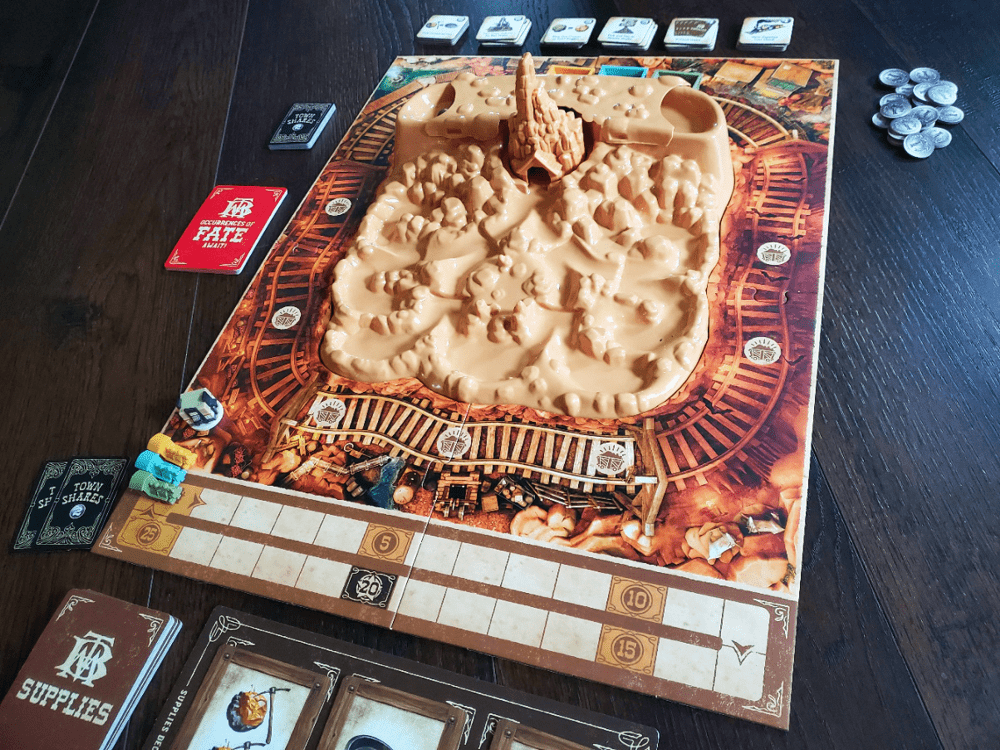
Each player receives a mine cart for gold and ore collection and a fantastic little locomotive that serves as a scoring marker. Player decks begin with eight Supplies cards that dictate the actions of a turn.
Player turns begin by rotating the Peak to release three marbles into the mines. Marbles in this game represent Gold, Ore, Water, and Fate. Once the marbles are settled, players choose from their hand of four cards which actions to take and in what order. Basic actions include movement, gathering gold and ore by picking or panning, bailing water from the shafts, or acquiring additional Supplies cards. Once a player has exhausted their hand, they draw up a new hand and play moves on.
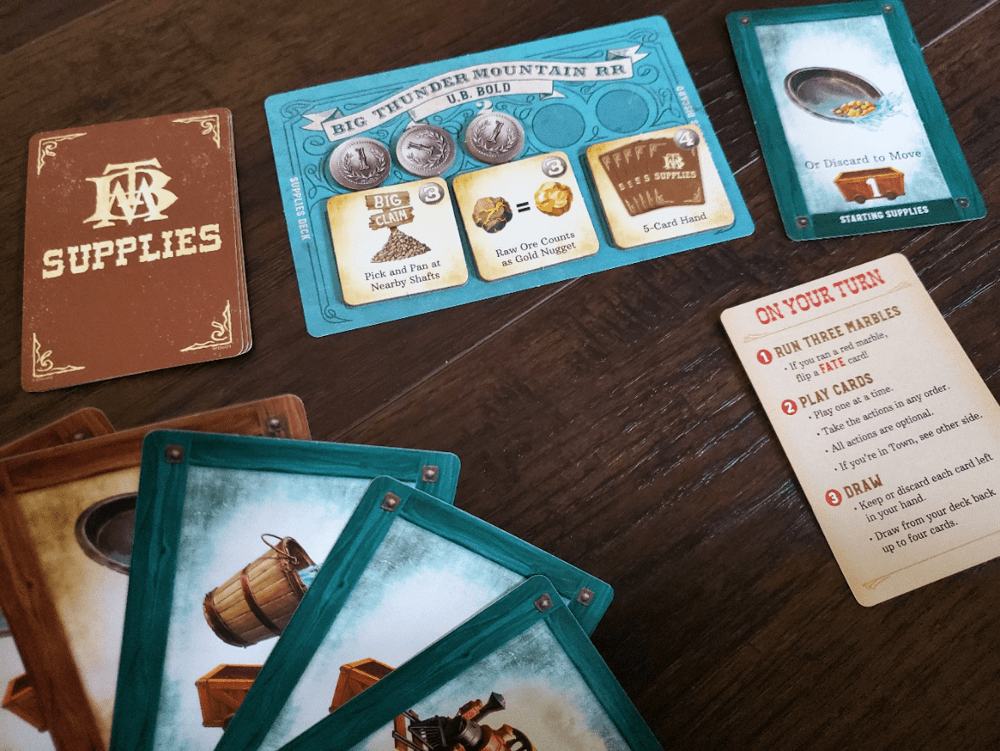
The flow of the game involves moving clockwise from shaft to shaft and interacting with the contents. Water can be a troublesome hindrance to mining (as any veteran of the Tinners’ Trail might know), but provides a bit of cash when the Bail action is taken. Gold and ore can be picked from dry mines and panned from wet mines, filling the cart to its limit of four marbles on the way to a stop in Town.
Town—the eighth space on the track—is tucked behind the mountain. Here players can sell their ore for coins or Victory points. Coins serve to purchase either Upgrades to the mining process or potentially lucrative Town Shares. Upgrades might allow players to hold a larger hand, to sell ore as if it were gold, to collect additional coins for Bailing water, or the like. Town Shares provide a random payoff of one to three points that remain hidden until the game’s end. Every visit to Town is a mix of actions and enhancements.
A singular red marble represents Fate on the mountain. When the red marble arrives on the scene, the active player draws a Fate card following marble distribution and carries out the command which might include moving carts, emptying a shaft, or releasing extra marbles. Once Fate has been resolved, the current turn continues.

Round and round the game goes until someone reaches 20 points at the end of a turn. The players who cross this threshold first, second, or even third depending on the player count, are given a bonus Town Share. Every other player then takes one additional turn before the endgame. Players have one final opportunity to sell any leftover gold in their carts at half price before revealing Town Shares and calculating final scores.
There’s something you should know
I have wildly mixed feelings about Big Thunder Mountain Railroad. The premise is simply lovely for a family weight game. Tossing marbles about, chasing said marbles, bumping the carts of family members into empty shafts, selling, and buying generate a wealth of activity throughout the game. The carts, marbles, and chunky choo-choo scoring markers are great fun to handle. This is the sort of game that kids spot and immediately want to play. It’s also the sort of game that has enough going on that parents shouldn’t mind obliging those youthful impulses.
But I have reservations.
First, the mountain. The plastic production leaves a little something to be desired. The Peak is not as easy to spin as I might like, and really needs to be grasped at the base to work well. It doesn’t always pick up a marble, which translates into extra spins which are exciting at first, but not so welcome by the middle of the game. I find myself wishing they had included a solid base for the Peak—one that sits on the table to prevent the flexing of the whole mountain as various hands reach in with various amounts of pressure to alter the landscape. I know this would have been a production challenge, but Big Thunder Mountain Railroad relies too heavily on the mountain for the component to be merely passable.
Second, the mountain. Marble distribution is skewed heavily toward the 4th shaft—the center space of the rondel. The fact that this places the majority of the action exactly opposite Town could be a design choice, but we had multiple plays where this shaft was packed to capacity plus one. In fact, the only reason there were often marbles in the shafts on either side of center is because the “No vacancy” sign in the middle forced the marbles to ricochet elsewhere. The game falls out of balance when four or even five of the seven shafts are starved for goodies while the center is repeatedly bogged down to the point of running out of marbles.

Third, turn length. Across multiple sittings, my twelve-year old daughter said numerous times, “Turns take forever in this game.” She’s not entirely wrong. I’ve already mentioned the finicky Peak as a repeat offender in wasted time. Beyond that, with a hand of four or five cards, there could be as many as twelve to fifteen icons to consider. First I’ll move then pick. Then I’ll move, bail, and pan. Then I’ll move and snag a new Supplies card. No wait, I’ll do this card then this card. Then I’ll… you get the idea. Add in the fact that every stop in town involves selling off mined goodies and shopping, and turns start to drag. Add in the fact that those fancy new Supplies cards with their hefty movements will enable multiple visits to Town in a single turn and you’re talking significant down time. Have I mentioned you’re often waiting for a child to make these decisions?
Fourth, game length. Despite numerous plays, we’ve not been able to get Big Thunder Mountain Railroad finished in under an hour with more than two players. I’d imagine a group of adults could do so, but is that really the target audience here? The box boasts a 45-minute run time. For more on why this isn’t necessarily so, see reservations 1-3. We happen to have a nine-year-old who can tolerate 80 minutes at the table, but it seems the folks at Funko were aiming for something faster.
Fifth, the Town Shares. In every game, the score has been tight as we hit the home stretch. Players are nearly always within a couple points of each other after the final gold is dumped at half price. Multiple strategies serve in reaching the finish line. In the end, victory comes down to the draw of Town Shares. In one game, I adopted a money-heavy strategy with quick upgrades, lots of Bailing, and many Town Shares. Had I drawn three-point or even two-point cards, I would have broken scoring records. History, however, will only ever know a stack of almost every one-point card in the lot and a crushing loss.
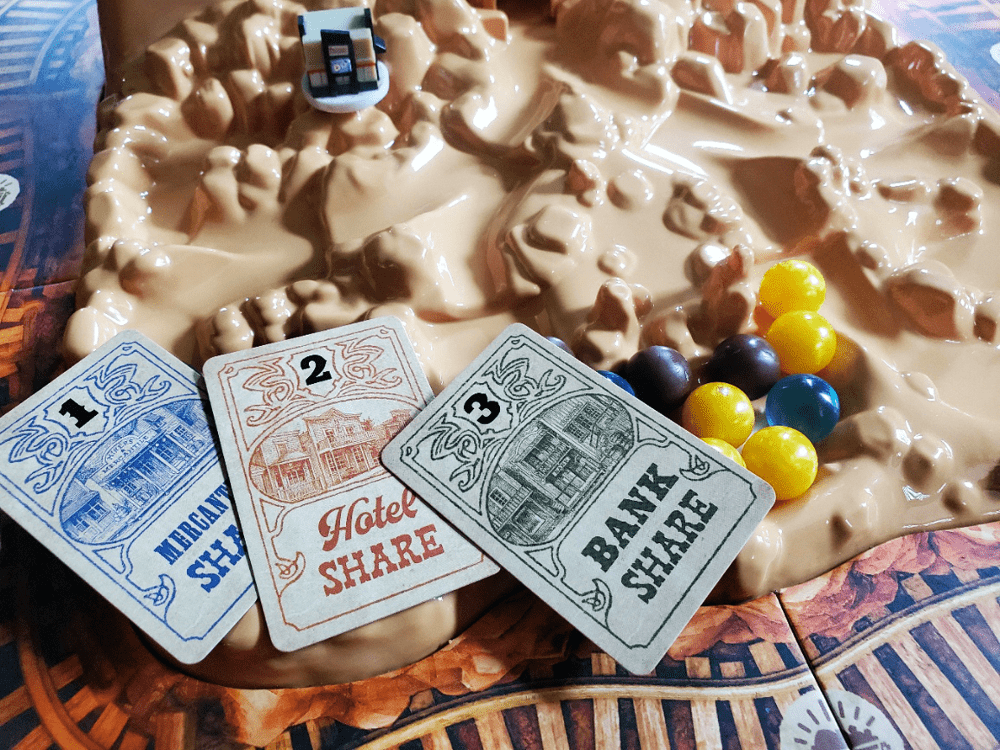
Despite my reservations, I must say—seemingly against all odds—Big Thunder Mountain Railroad contains some fun. When the Peak cooperates, I get those Wheeeeeeeee feelings from childhood all over again. When the marbles actually scatter all over there are some wonderful decisions and combos ripe for the picking. When folks (children) are attentive to the board and ready for the next visit to Town, the Upgrades are timely, fascinating, and feel significant. I don’t even mind the highly consequential luck of the Town shares if I’m being honest—sometimes the swing is exciting.
What I mind is that there are so many possibilities for the train to derail and the mountain to crumble. I don’t regret my hours at the table with this one—they are hours with family, after all and they unearthed a bit of that fun. But if I’m to spend this much time, I’m just not sure Big Thunder Mountain Railroad delivers the gold. In the game of life, there are better opportunities afoot.


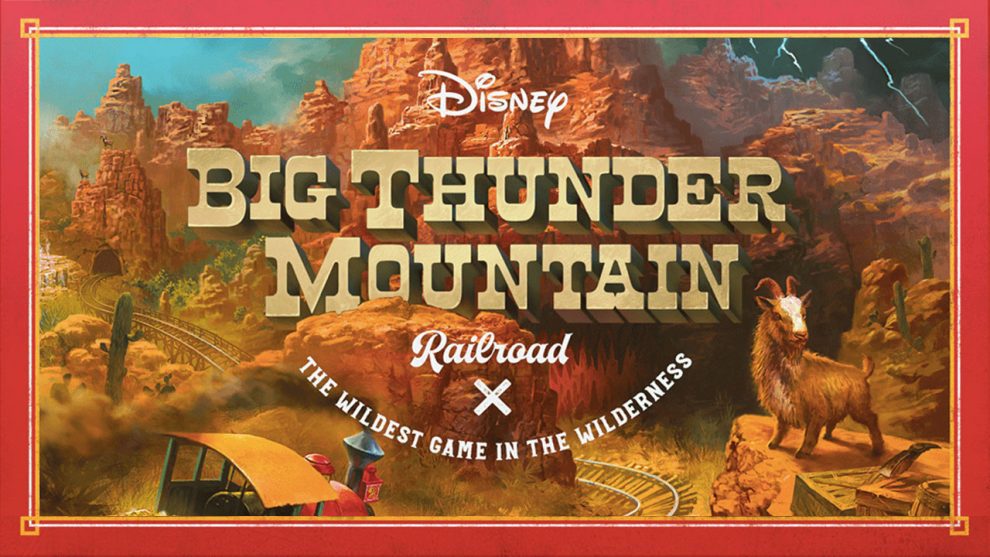


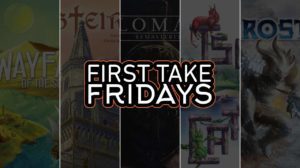

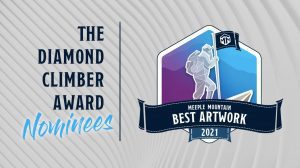




I agree with your take on the mountain and the not so randomness of the marbles falling. The turning and reloading of marbles from the basin.
Thanks for the comment! I can only imagine the engineering required to achieve perfect distribution! I still wonder if it wasn’t intentional. I can’t believe the anomaly didn’t manifest in playtesting. I really do wish some of these fiddly quirks weren’t there, as there is a solid game lurking somewhere beneath the surface issues. There are just too many of them!